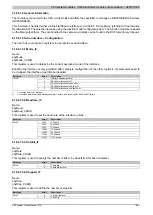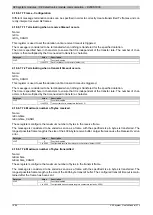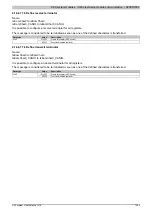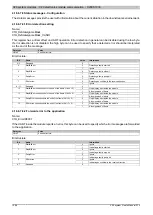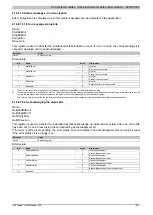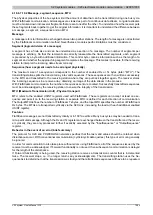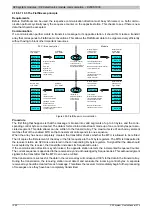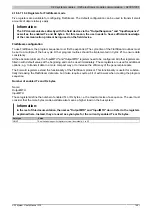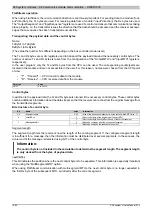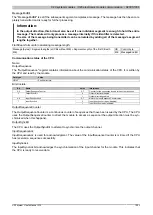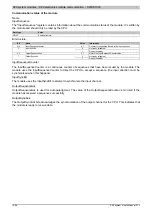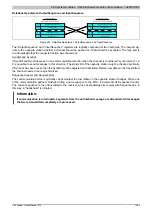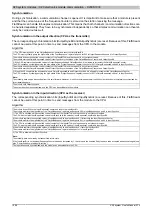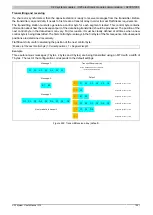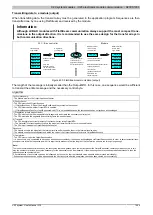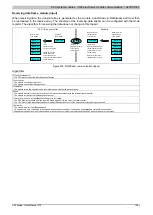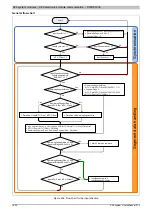
X20 system modules • X20 electronics module communication • X20CS1030
X20 system User's Manual 3.10
1589
4.18.6.7.10.2 Message, segment, sequence, MTU
The physical properties of the bus system limit the amount of data that can be transmitted during one bus cycle.
With FlatStream communication, all messages are viewed as part of a continuous data stream. Long data streams
must be broken down into several fragments that are sent one after the other. To understand how the receiver puts
these fragments back together to get the original information, it is important to understand the difference between
a message, a segment, a sequence and an MTU.
Message
A message refers to information exchanged between two partner stations. The length of a message is not restricted
by the FlatStream communication method. Nevertheless, module-specific limitations must be considered.
Segment (logical division of a message)
A segment has a finite size and can be understood as a section of a message. The number of segments per
message is arbitrary. So that the recipient can correctly reassemble the transmitted segments, each segment
is preceded by a byte with additional information. This control byte contains information such as the length of a
segment and whether the approaching segment completes the message. This makes it possible for the receiving
station to interpret the incoming data stream correctly.
Sequence (how a segment needs to be arranged physically)
The maximum size of a sequence corresponds to the number of enabled Rx or Tx bytes (later: "MTU"). The
transmitting station splits the transmit array into valid sequences. These sequences are then written successively
to the MTU and transmitted to the receiving station where they are put back together again. The receiver stores
the incoming sequences in a receive array, obtaining an image of the data stream in the process.
With FlatStream communication, the number of sequences sent are counted. Successfully transmitted sequences
must be acknowledged by the receiving station to ensure the integrity of the transmission.
MTU (Maximum Transmission Unit) - Physical transport
MTU refers to the enabled USINT registers used with FlatStream. These registers can accept at least one se-
quence and pass it on to the receiving station. A separate MTU is defined for each direction of communication.
The OutputMTU defines the number of FlatStream Tx bytes, and the InputMTU specifies the number of FlatStream
Rx bytes. The MTUs are transported cyclically via the X2X Link, increasing the load with each additional enabled
USINT register.
Features
FlatStream messages are not transmitted cyclically or in 100% real time. Many bus cycles may be needed to trans-
mit a particular message. Although the Rx and Tx registers are exchanged between the transmitter and the receiv-
er cyclically, they are only processed further if explicitly accepted by the "InputSequence" or "OutputSequence"
register.
Behavior in the event of an error (brief summary)
The protocol for X2X and POWERLINK networks specifies that the last valid values should be retained when
disturbances occur. With conventional communication (cyclic/acyclic data queries), this type of error can generally
be ignored.
In order for communication to also take place without errors using FlatStream, all of the sequences issued by the
receiver must be acknowledged. If Forward functionality is not used, then subsequent communication is delayed
for the length of the disturbance.
If Forward functionality is being used, the receiving station receives a transmission counter that is incremented
twice. The receiver stops, i.e. it no longer returns any acknowledgments. The transmitting station uses the Se-
quenceAck to determine that the transmission was faulty and that all affected sequences will have to be repeated.
Summary of Contents for X20 System
Page 2: ......







